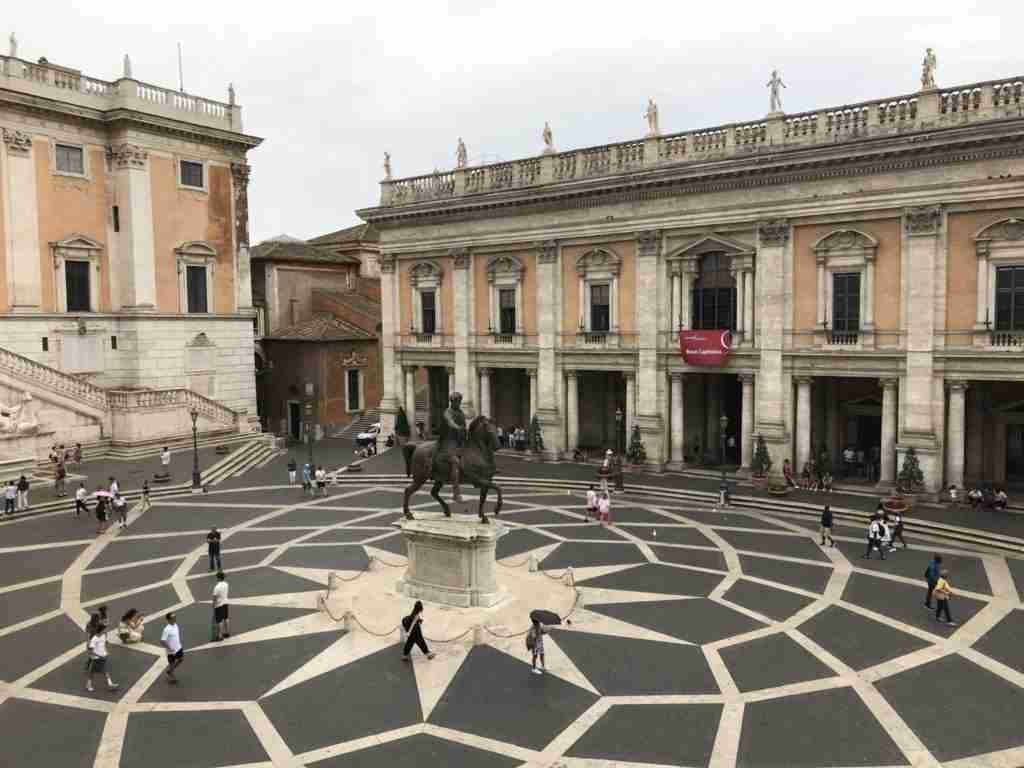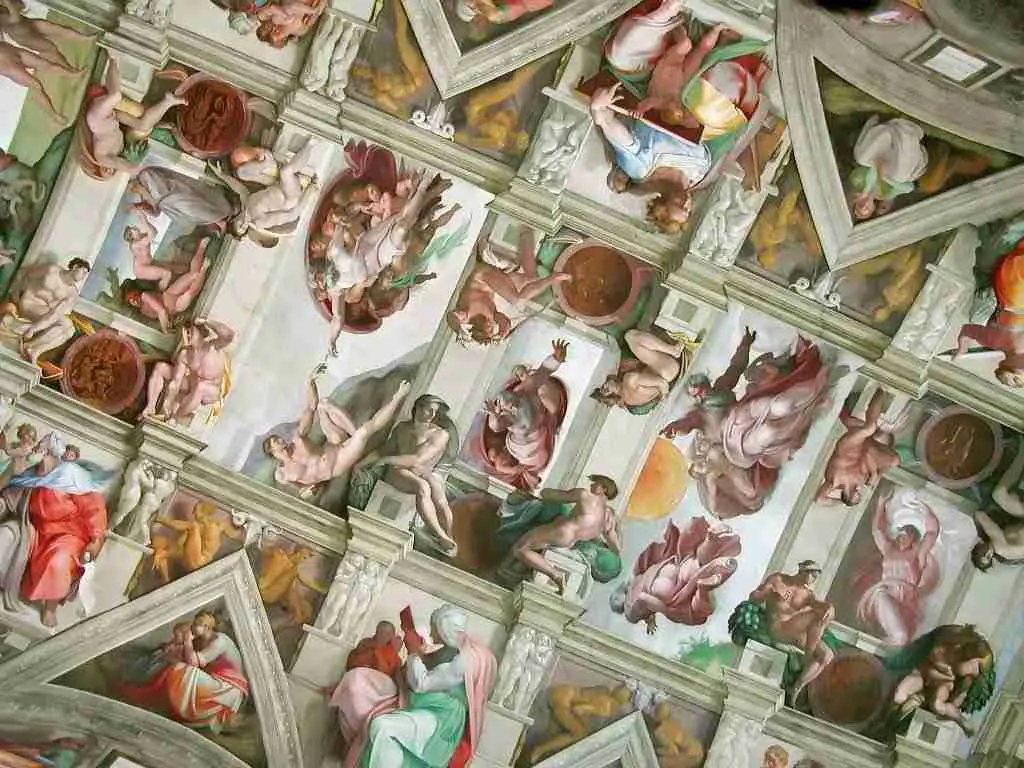One lifetime isn’t enough time to see all the treasures of Rome. So it goes without saying that three days in the Italian capital will leave you wanting more.
But one way that you can structure a Rome itinerary that takes in the city’s greatest monuments and its lesser known gems is to follow in the footsteps of Italy’s greatest artists. Master Renaissance painter, sculptor, and architect Michelangelo is an obvious artist with which to begin.
Michelangelo Buonarotti (born 6 March 1475, died 18 February 1564) is most associated with Rome because of his masterpieces in the Sistine Chapel. But his work is all over the city and it is well worth the effort to seek it out.
Michelangelo in Vatican City: The Sistine Chapel Frescoes and the Pietà

In order to see the incredible frescoes that Michelangelo painted on the ceiling and altar wall of the Sistine Chapel, one must pay a visit to the Vatican Museums (Musei Vaticani) in Vatican City. Michelangelo painstakingly worked on these incredible images of scenes from the Old Testament and The Last Judgment from 1508 until 1512.
The Vatican Museums tour is routed in such a way that the Sistine Chapel is the final stop. You can book self-guided, guided, and other exclusive tours of the Vatican Museums through the Vatican website. I highly recommend a guided tour of the Vatican to get the most out of your visit.
Next door, in St. Peter’s Basilica, is one of Michelangelo’s marble masterpieces. The tender and refined Pietà, completed in 1499 when Michelangelo was only 24, depicts the Virgin Mary holding her dying son in her arms. Unfortunately, due to past attempts to vandalize the sculpture, the Pietà is located behind glass (in a chapel to the right of the basilica entrance), so it is hard to get close enough to inspect Michelangelo’s mastery.
A visit to Saint Peter’s is typically combined with a visit to the Vatican Museums, but it doesn’t have to be. Note that you don’t need a ticket to enter Saint Peter’s Basilica, only patience for standing in a long security line.
Piazza del Campidoglio

In addition to painting and sculpture is Michelangelo’s contribution to city planning. His design for the elliptical piazza is located on top of the Capitoline Hill, the site of Rome’s government. Michelangelo drew up plans for the cordonata (the wide, monumental stairway) and the intricate geometric pattern of the Piazza del Campidoglio in approximately 1536, but the project was not completed until long after his death.
Piazza del Campidoglio one of my favorite squares in Rome. It is a beautiful example of civic planning best viewed from the buildings of the Capitoline Museums, which frame it on two sides.
Moses in San Pietro in Vincoli

In San Pietro in Vincoli, a church located tucked away on a hill halfway between the Colosseum and the trendy Monti neighborhood, you will find Michelangelo’s monumental marble of Moses, which he sculpted for the tomb of Pope Julius II. Moses and the surrounding statues of the composition in this church were to be part of a far more grandiose tomb, but Julius II was instead buried in Saint Peter’s Basilica. Michelangelo’s unfinished sculptures of “Four Prisoners,” which are today located in the Galleria dell’Accademia in Florence, were also supposed to accompany this work.
Cristo della Minerva (Risen Christ)

This statue of Christ in the beautiful Gothic church of Santa Maria Sopra Minerva is far less impressive than the Michelangelo’s other sculptures. Completed in 1521, the sculpture depicts Christ, in a contrapposto stance, holding up his cross. Oddly, this sculpture is also wearing a loin cloth, a Baroque-era addition meant to make decent Michelangelo’s nude sculpture. Santa Maria Sopra Minerva is located around the corner from the Pantheon, so a visit to this church should fit into any itinerary.
The Church of Santa Maria degli Angeli e dei Martiri and Michelangelo’s Cloister

Michelangelo was in charge of designing the Basilica of Saint Mary of the Angels and Martyrs around the ruins of the frigidarium part of the ancient Baths of Diocletian. The interior of this cavernous church has changed since Michelangelo designed it, the decor is mostly Baroque. Yet it a fascinating building to visit in order to get a sense of the size of the ancient baths as well as Michelangelo’s genius in designing around them.
The rest of Diocletian’s Baths now form a branch of the National Museum of Rome. A visit to this museum lets you get a closer look at the baths as well as the art, everyday objects, and tools that make up Rome’s history. The museum also houses a cloister, which Michelangelo planned as the charterhouse to his church next door. Work on the cloister did not begin until 1565, one year after the artist’s death. But this garden, surrounded by Ancient Roman sculpture and funerary fragments, is still called “Michelangelo’s Cloister” and it is a very lovely place to go should you need a quiet escape from Rome.
Porta Pia

Porta Pia, Michelangelo’s last architectural work, is yet another monument that the artist designed but was completed after his death. Built between 1561 and 1565, Porta Pia was named after its patron Pope Pius IV who commissioned its construction to replace the Porta Nomentana.
Map of Michelangelo Sites in Rome
Further Reading on Michelangelo in Rome
Should you wish to know more about Michelangelo in Rome–indeed, this post covers very basic info about the man and his art–I recommend a few books:
- Michelangelo and the Pope’s Ceiling by Ross King
- Michelangelo: The Complete Paintings, Sculpture, and Architecture by Taschen
- The Sistine Secrets: Michelangelo’s Forbidden Messages in the Heart of the Vatican by Rabbi Benjamin Blech and Roy Doliner
- The Agony and the Ecstasy by Irving Stone
Post first published on March 6, 2019


Leave a comment